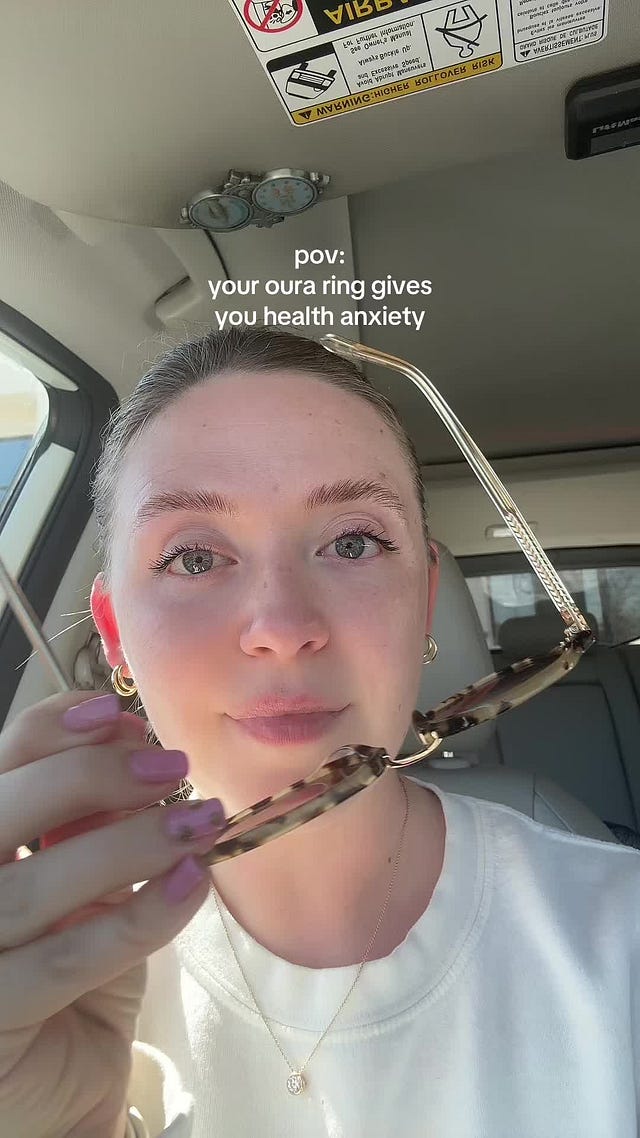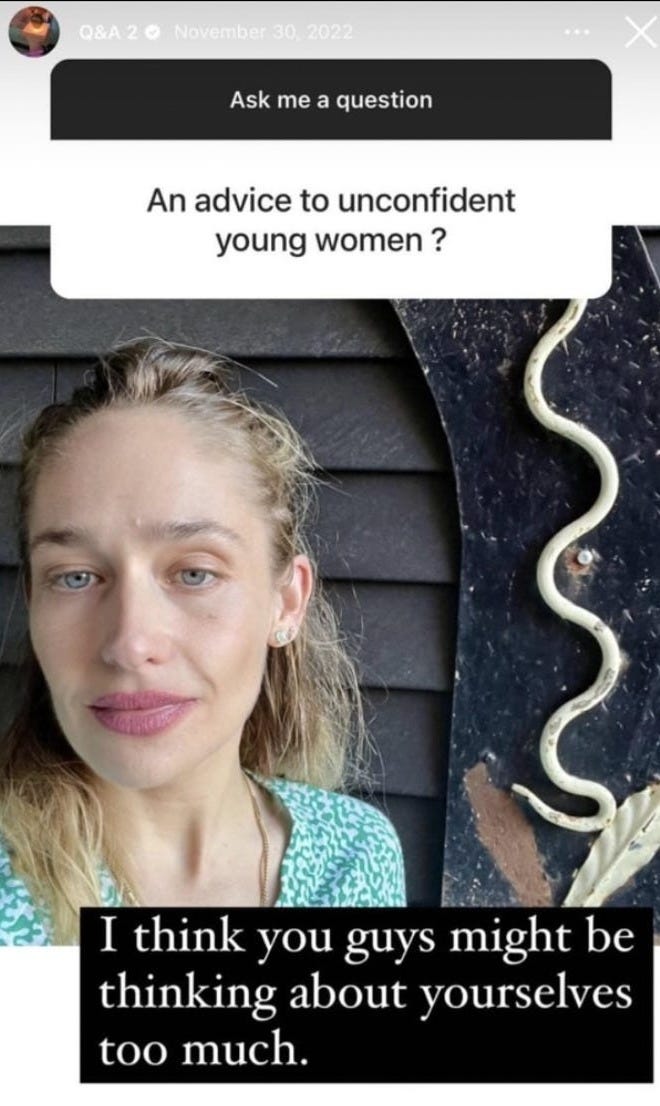Last week, I got off an evening C train in Fort Greene to a poster reading “GIVE US THE FINGER,” followed by a gentler — though more unsettling — line: “the science of self-care.”
This was the latest ad from Oura, the Finnish health technology company that launched the Oura Ring, a first of its kind “smart ring,” 10 years ago in March 2015. Initially, the innovation seemed compelling. If other fitness trackers from brands like Garmin, Fitbit, and Apple were too clunky, the Oura Ring was a discreet, even elevated, alternative. It would track your activity, recovery, and sleep, as well as other metrics like body temperature, blood oxygen, and stress levels, all moderated through the Oura app. Available in six colors, including gold-, rose gold-, and silver-toned titanium, it was designed to blend in with the rest of your jewelry.
Soon, major celebrities were wearing the Oura Ring. Jennifer Aniston spoke about it on Jimmy Kimmel. Prince Harry, Elizabeth Arden aficionado, has been spotted in it a time or two. Not unexpectedly, Gwyneth Paltrow has been wearing hers for years and was an early investor. In 2024, Fortune Business Insights reported the global fitness tracker market has a value of around $62 billion. This year, the market is projected to grow to over $72 billion. It’s no surprise that North America, where health care has been systematically degraded and wellness upheld as an aestheticized consumer category, is the primary market for these devices.
Since last fall, the Oura Ring’s popularity has hit a fever pitch, though it’s hardly all positive. On TikTok, droves of young women are claiming that the ring has exasperated their already existing health anxiety or given it to them anew. Now, many of them are forgoing their investment altogether (depending on which edition of the Oura Ring you buy, it can run you up to $500 USD). The New York Times just reported a piece on the phenomenon, dubbing it “Oura paranoia.”
“I fear I’m going to have to get rid of my Oura Ring because I am feeling judged,” said TikTok user Abi Caswell. “Last night, I went out to dinner with friends, I wanted a cocktail so bad. I didn’t order a cocktail because I was worried what my readiness score the next day was going to be.”
It’s not nothing that the recent Oura Ring boom has coincided with the proliferation of #SkinnyTok. (The hashtag was just banned in large part thanks to this story published in The Cut.) Simultaneously, the mainstreaming of AI and surveillance capitalism is pulling us further from our own instincts. Rather than intuit your own tiredness or dehydration, turn to this shiny band, which may be able to tell you better, or so is the premise.
I’ve spent a lot of time thinking about how this turn toward a metric understanding of the self might actually be eroding our well-being. And opposingly, how turning toward basic pleasure — which Big Wellness would like us to lump under the umbrella of indulgence and excess — might move us closer to a more vibrant version of ourselves.
Though wellness as an individualized consumer category has seen accelerated growth since 2020, the boom had been building for a long time pre-pandemic. In 2019, I was accepted to graduate school on a proposal to research the commodification of feminist self-care, a concept I’d first started writing about during my final semesters of college. At the time, DTC beauty brands were taking over (with Glossier at the top of the food chain) and the “girlboss” was yet to be toppled. In a period of political uncertainty, Audre Lorde was regularly invoked by brands, influencers, and public figures for her writing on self-care: “Caring for myself is not an act of self-indulgence, it is self-preservation, and that is an act of political warfare.”
Lorde wrote that line in 1988. She had liver cancer, which she ultimately died of, and was reckoning with questions of “cure” within a set of Black lesbian feminist politics. In the late 2010s beauty world however, this context and specificity was stripped and so arrived the cult of self-care-meets-colloquial-therapy speak we have now.
Jia Tolentino once explained the appropriation of Lorde’s vision of self-care as “widely reinterpreted as an end in itself, rather than a means to an end — like, a way to have a better life, rather than a way to equip oneself to be a better community member and citizen.” She gets at both the individualism that has warped our culture so completely that even the most basic manners are thought to be kindness, as well as the idea that self-care was supposed to make each individual life easier, rather than make us more equipped because life, no matter how you slice it, is very hard.
Less quoted on the subject is Toni Cade Bambara, whose novel The Salt Eaters was threaded through much of my year in that graduate program. Early in the book, one of the characters, a healer, repeatedly asks a younger woman who wishes to get better if she’s really ready: “Just so’s you’re sure, sweetheart, [...] cause wholeness is no trifling matter. A lot of weight when you’re well.”
In that line, there’s an imperative that being well, being whole, being on the other side of a certain kind of care, actually bears difficulty. Because, by then, maybe you’re prepared to face how devastating life can be. In many ways, that line of thinking — the idea that you might actually have to contend with particular realities — works in opposition to these optimization metrics we have now, which promote a personalized, static ideal. Of course, these devices are supposed to make our climb to that ideal easier, more frictionless, when in reality many users are living in fear of fictional sleep maladies and ruled by restrictive practices.
I’m as entrenched in the traps of optimized personhood — or worse, womanhood — as anyone else. I go to fitness classes; I can’t imagine a day without examining the way I look in a full-length mirror. But I want to counter those impulses with a general skepticism of any commercial attempt to sell us the idea that we can be made better in a closed-loop exchange of money spent on an object that exists solely to orient us back to ourselves.
From there, we might start to understand whether or not we are participating in commodified self-care or something more transformative. Do my rituals exist for the sake of themselves, or are they sending me back into the world? So much of this health paranoia is fueled by an obsession with the quantifiable self — these devices require our self-consciousness to justify their existence. Instead, how might we raise our community consciousness, which in turn, might be the very thing that liberates us from this socially encouraged trap of self-obsession?
Following the publication of the New York Times story on the Oura Ring, Emily Sundberg, founder and editor of the popular daily business newsletter, Feed Me, initiated a subscriber chat to discuss the story and the ring itself. “I believe Oura rings are cops on a finger,” she wrote, followed by a link to the article. It garnered over 200 replies.
Likewise, one subscriber, Steven Swyryt, remains unconvinced of the ring’s utility: “Everyone’s just so worried about sleep and stress and trackers when really what they need to do is sit down for ten minutes in the sun and have an Americano and a cig.”
It would be easy for me to talk about the Oura Ring boom as a result of living in times when conditions are so uncertain. That people are turning to trackers as an exercise of control. But I think it’s much simpler — this mass pursuit of optimization has become a cultural default, it’s not new. More likely, we’re all much more capable of buying into trends and gimmicks than we think we are, and in chasing perfect performance, become less and less capable of navigating the shaky bounds between our own personhood and product.






Thanks for sharing this perspective, so different from my experience of it! I've had an Oura Ring for a year and absolutely love it. It’s helped me understand my cycle so much better, especially how my body temperature is tied to it.
It’s fascinating to see how your body literally runs hotter before your period. I never understood why I would sweat more during certain parts of the month.
Also, seeing how good sleep affects my day, or how a late meal impacts my sleep, has been super insightful. I’ve started valuing sleep a lot more because of it. Even naps! I never allowed myself to nap (hi, culture of hustle and performance), and thanks to Oura, I’m now like, wow, a nap really helps!
I have to admit that I’ve been able to view Oura’s data from a learning perspective rather than with anxiety. For me, the anxiety actually comes from Instagram and TikTok, the visual overload of “perfect,” fit young women and men, and less so from raw data.
I had no idea people were experiencing anxiety from this, but I can totally see it. Thanks for sharing!
We are so estranged from ourselves that we depend on machinery to give us a read on our bodies. This is so sad. Great article.